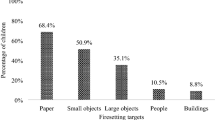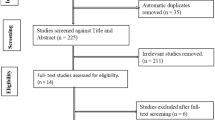Abstract
House fires are a common occurrence in the United States, often happening as isolated, personal disasters. This qualitative study examines the responses of 12 children, ages 6 to 17, who were survivors of 12 separate home fires in a Mid-Atlantic city. Two thirds of the families involved were single-parent families receiving public welfare. Children were interviewed between three and four months after the fire. Nine categories concerning the fire experience and its aftermath were identified: exposure, loss, displacement, attribution, stress responses, changes in relationships, self-report of changes in behavior, child's perception of parent's stress and child's view of adulthood and the future. Psychosocial themes that emerged included a sense of fear and blame, sleep disturbances, and a sense of vulnerability. Parents rated their children on a quantitative measure of behavior and social competence. The behavior rating scale revealed that half of the parents rated their child's adjustment after the fire as “not normal”. Children's reactions to larger-scale disasters are indicated. Implications of these findings for social work practice are discussed.
Similar content being viewed by others
References
Achenbach, T.M. & Edelbrock, C. (1991).Manual for the child behavior checklist and revised child behavior profile. Burlington: University of Vermont, Dept. of Psychiatry.
American Psychiatric Association (1987)Diagnostic and statistical manual of mental disorders. (3rd ed., revised), Washington, D.C.
Benedek, E.P. (March, 1985). Children and disaster: Emerging issues.Psychiatric Annals.15/3, 168–172.
Duncan, M. & Popper, C.W. (1991).Child and adolescent psychiatry. Washington, D.C.: American Psychiatric Press, Inc., pp. 111–114.
Frederick, C.S. (1985). Children traumatized by catastrophic situations. In S. Eth & R.S. Pynoos (Eds.)Post-Traumatic Stress Disorder in Children. Washington, D.C.: American Psychiatric Press, Inc. Chapter 4.
Earls, F., Smith, E., Reich, W. & Jung, K. (1987) Investigating psycho-pathological consequen of a disaster in children: A pilot study incorporating a structured diagnostic interview.Journal of American Academy of Child Adolescent Psychiatry, 271:90–95.
Eth, S., & Pynoos, R.S. (Eds.). (1985).Post-traumatic stress disorder in children. Washington, D.C.: American Psychiatric Press.
Eth, S., & Pynoos, R.S. (1986). Developmental perspectives on psychic trauma in childhood. In Figley, C.R. (Ed.).Trauma and its wake. New York: Brunner/Mazel.
Garmezy, N., & Rutter, M. (1985). Acute reactions to stress. In Rutter, M. & Hersov, L. (Eds.)Child and adolescent psychiatry: Modern approaches. Oxford, Blackwell, 152–176.
Gaynor, J., & Hatcher, C. (1987).The psychology of child firesetting: Detection and intervention. New York: Brunner/Mazel.
Gulaid, J.A., Sattin, R.W., Waxweiler, R.J. (Feb. 1988). Deaths from residential fires, 1978–1984.MMWR CDC Surveillance Services, 37, No. SS-1, 39–45.
Hook, J.G. (1989). Heider's foreseeability level of responsibility attribution: Does it come after intentionality?Child Development, 60, 1212–1217.
Jones, R.T., & Ribbe, D.P. (Oct. 1991). Child, adolescent, and adult victims of residential fire: Psychosocial consequences.Behavior Modification, 15, (4), 560–580.
Jones, R.T., Ribbe, D.P., & Cunningham, P. (1994). Psychosocial correlates of fire disaster among children and adolescents.Journal Traumatic Stress, 7(1), 117–122.
Keane, A., Pickett, M., Jepson, C., McCorkle, R. & Lowery, B. (1994). Psychological distress in survivors of residential fires.Social Science and Medicine, 38,(8), 1055–1060.
Knafl, K.A. & Webster, D.C. (1988). Managing and analyzing qualitative data: A description of tasks, techniques, and materials.Western Journal of Nursing Research, 10 (2), 195–218.
Kolko, D.J. & Kazdin, A.E. (1986). A conceptualization of firesetting in children and adolescents.Journal of Abnormal Child Psychology, 14 (1), 49–61.
Kolko, D.J. & Kazdin, A.E. (1988). Parent-child correspondence in identification of fire-setting among child psychiatric patients.Journal of Child Psychology Psychiatry, 29(2), 175–184.
Kolko, D.J. & Kazdin, A.E. (1989). The children's firesetting interview with psychiatrically referred and non referred children.Journal of Abnormal Child Psychology, 17(2), 609–624.
Kolko, D.J. & Kazdin, A.E. (1989). Assessment of dimensions of childhood firesetting among patients and non-patients: The firesetting risk interview.Journal of Abnormal Child Psychology, 17 (2), 157–176.
Krim, A. (1976). Urban victims of fires. In H. Parad, L. Parad and H. Resnick, (Eds.).Emergency and disaster management (pp. 337–351), Bowie, Md: Charles Press.
Lifton, R., & Olsen, E. (1976). The human meaning of disaster.Psychiatry, 39: 1–18.
McFarlane, A.C. (1987). Posttraumatic phenomena in a longitudinal study of children following a natural disaster.Journal of the American Academy of Child and Adolescent Psychiatry, 26, (5), 764–769.
Miles, M.B., & Huberman, A.M. (1984).Qualitative data analysis: A sourcebook of new methods. Beverly Hills: Sage.
Mowbray, C.T. (1988). Post-traumatic therapy for children who are victims of violence. In F.M. Ochberg (Ed.).Post-traumatic therapy and victims of violence (pp. 196–212), New York: Brunner/Mazel.
Murphy, S.A. (Sept/Oct, 1989). Multiple triangulation: Applications in a program of nursing research,Nursing Research, 38 (5), 294–297.
Newman, C.J. (March, 1976). Children of disaster: Clinical observations at Buffalo Creek.American Journal of Psychiatry, 113 (3), 306–312.
Pynoos, R.S., Frederick, C., Nader, K., Arroyo, W., Steinberg, A., Eth, S., Nunez, F. & Fairbanks, L. (1987). Life threat and post-traumatic stress in school-age children.Archives of General Psychiatry (44), 1057–1063.
Terr, L.C. (1989). Treating psychic trauma in children: A preliminary discussion.Journal of Traumatic Stress 2(1), 3–20.
United States Department of Commerce, Bureau of the Census. (1990).Statistical abstracts of the United States, p. 198. Washington, D.C.: U.S. Government Printing Office.
Webb, N.B., Sakheim, G.A., Towns-Miranda, L., & Wagner, C.R. (April, 1990). Collaborative treatment of juvenile firesetters: assessment and outreach.American Journal of Orthopsychiatry, 60(2), 305–310.
Yule, W. & Williams, R.M. (1990). Post-traumatic stress reactions in children.Journal of Traumatic Stress, 3(2), 279–295.
Author information
Authors and Affiliations
Additional information
This study was supported by a grant from the Hassel Foundation, Philadelphia, PA.
Rights and permissions
About this article
Cite this article
Greenberg, H.S. Responses of children and adolescents to a fire in their homes. Child Adolesc Soc Work J 11, 475–492 (1994). https://doi.org/10.1007/BF01876571
Issue Date:
DOI: https://doi.org/10.1007/BF01876571




